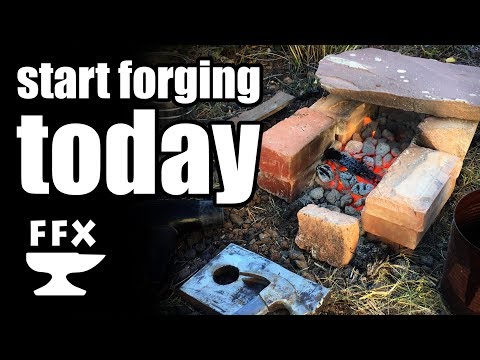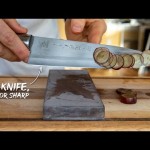
3312fc2eb81253d6e6ef18b6e55c8a20
Forging a knife is a rewarding and satisfying experience. It is a skill that requires patience, practice, and dedication. Whether you are a beginner or an experienced blacksmith, this guide will provide you with the necessary steps to forge a knife. From selecting the right materials to heat treating and sharpening, this guide will provide you with the information you need to create a beautiful and functional knife. So, let’s get started!
What is the process of forging a knife
Forging a knife is an ancient art that has been practiced for centuries. It involves heating metal to a high temperature and then hammering it into shape. The process of forging a knife is a complex one that requires skill and patience. It is a craft that has been passed down through generations and is still practiced today.
The first step in forging a knife is to select the right type of metal. Different metals have different properties and will require different techniques to forge. Common metals used for forging knives include carbon steel, stainless steel, and Damascus steel. Once the metal is chosen, it must be heated to a high temperature in order to be malleable enough to be shaped.
The next step is to shape the metal. This is done by hammering the metal on an anvil. The metal is heated and then hammered into the desired shape. This process is repeated until the desired shape is achieved. The metal is then cooled and hardened to make it more durable.
The final step in forging a knife is to sharpen the blade. This is done by grinding the blade on a sharpening stone. The blade is then honed and polished to give it a smooth finish. The blade is then ready to be used.
Forging a knife is a time-consuming process that requires skill and patience. It is a craft that has been passed down through generations and is still practiced today. With the right tools and techniques, anyone can learn to forge a knife and create a beautiful and functional piece of art.
What is the first step in forging
Forging is a process of shaping metal into a desired shape by applying compressive forces. It is one of the oldest metalworking processes, and is still widely used today. The first step in forging is to prepare the metal for the process. This involves heating the metal to a temperature that is suitable for forging. The metal must be heated to a temperature that is high enough to make it malleable, but not so high that it melts.
Once the metal is heated, it is placed in a die or mold. This is a cavity that is designed to shape the metal into the desired shape. The die is usually made of a harder material than the metal being forged, such as steel or cast iron. The die is then placed in a press or hammer, which applies the compressive force to the metal. This force is what shapes the metal into the desired shape.
The next step in forging is to cool the metal. This is done to ensure that the metal retains its shape and strength. Depending on the type of metal being forged, the cooling process can take anywhere from a few minutes to several hours. Once the metal has cooled, it is ready to be used in whatever application it was intended for.
Forging is a complex process that requires skill and experience. It is important to understand the process and the materials being used in order to ensure that the desired results are achieved. With the right tools and knowledge, anyone can learn to forge metal and create beautiful and durable products.
How do I start bladesmithing
Bladesmithing is an ancient craft that has been around for centuries.
It involves the forging of metal into blades, such as swords, knives, and other edged weapons. Bladesmithing is a skill that requires patience, practice, and dedication. If you are interested in learning how to bladesmith, here are some tips to get you started.
Gather the Necessary Tools
The first step in bladesmithing is to gather the necessary tools. You will need a forge, an anvil, hammers, tongs, and other tools. You can purchase these items from a local blacksmithing supply store or online. You may also need to purchase some safety equipment, such as gloves, goggles, and a face shield.
Learn the Basics
Once you have the necessary tools, it is time to learn the basics of bladesmithing. You can find tutorials online or take classes from a local bladesmith. Learning the basics will help you understand the process and give you the confidence to start forging blades.
Practice
Once you have the basics down, it is time to start practicing. Start with simple projects, such as forging a knife or a small sword. As you become more comfortable with the process, you can move on to more complex projects. Practice is the key to becoming a successful bladesmith.
Find a Mentor
Finding a mentor is a great way to learn more about bladesmithing. A mentor can provide guidance and advice, as well as help you hone your skills. You can find a mentor by asking around at local blacksmithing events or by searching online.
Join a Bladesmithing Community
Joining a bladesmithing community is a great way to connect with other bladesmiths and learn more about the craft. You can find online forums and social media groups dedicated to bladesmithing. You can also attend local events and meet other bladesmiths in person.
Conclusion
Bladesmithing is a rewarding craft that requires patience, practice, and dedication. If you are interested in learning how to bladesmith, start by gathering the necessary tools, learning the basics, and practicing. You can also find a mentor and join a bladesmithing community to help you hone your skills.
How long does it take a Bladesmith to make a knife
Knives are essential tools for everyday life, and bladesmiths are the skilled artisans who craft them. But how long does it take a bladesmith to make a knife? The answer depends on the type of knife being made, the complexity of the design, and the experience of the bladesmith.
For a simple knife, such as a kitchen knife, a bladesmith may be able to complete the project in a few hours. This includes the time it takes to heat and shape the metal, grind the blade, and sharpen the edge. For a more complex knife, such as a hunting knife, the process may take several days or even weeks.
The experience of the bladesmith is also a factor. A novice bladesmith may take longer to complete a project than an experienced one. An experienced bladesmith may be able to complete a project in a fraction of the time it would take a novice.
The type of metal used is also a factor. Some metals are easier to work with than others, and some require more time to heat and shape. For example, a bladesmith may be able to complete a project with stainless steel in a few hours, but it may take several days to complete a project with Damascus steel.
Finally, the complexity of the design is a factor. A simple knife may take a few hours to complete, while a more complex design may take several days or even weeks. A bladesmith may also need to spend extra time on details such as engraving or etching.
In conclusion, the amount of time it takes a bladesmith to make a knife depends on the type of knife being made, the complexity of the design, the experience of the bladesmith, and the type of metal used. A simple kitchen knife may take a few hours to complete, while a more complex design may take several days or even weeks.
We hope this beginner’s guide to forging a knife has been helpful to you. Remember to take your time and practice safety when forging. With patience and practice, you’ll be able to create beautiful knives in no time!
Goodbye and happy forging!















